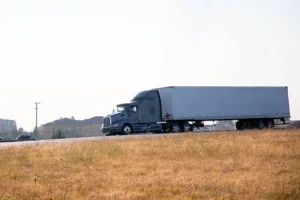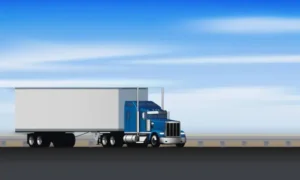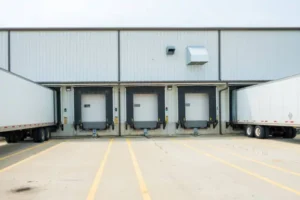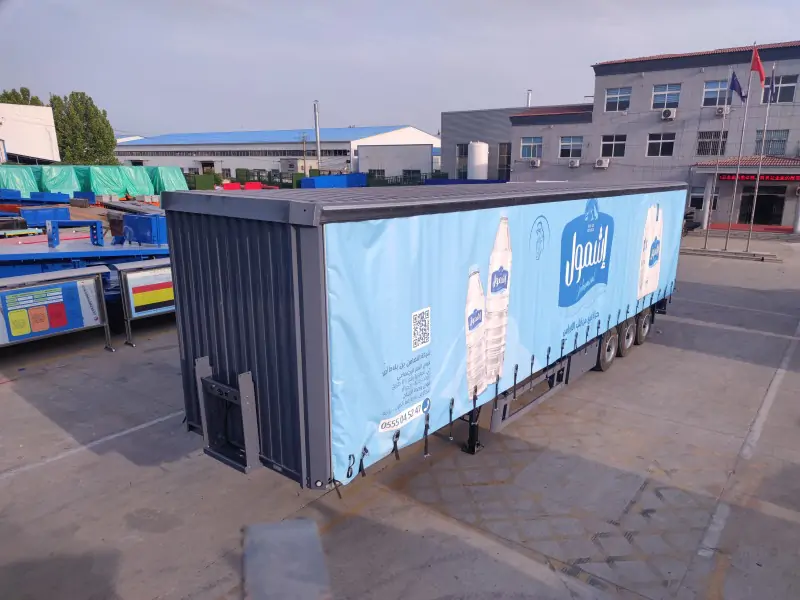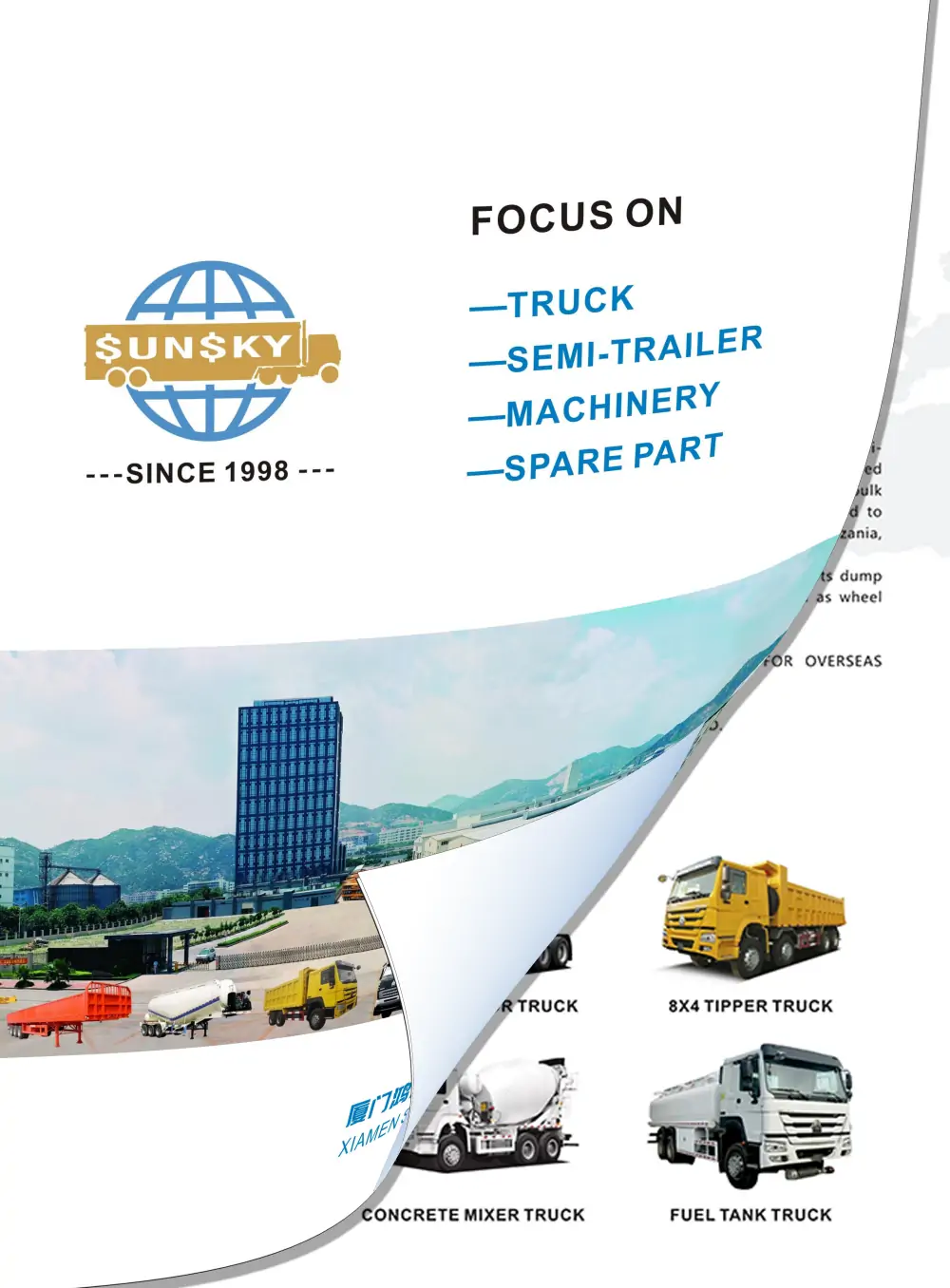Introduction — Why Dry Freight Trailers Matter
In today’s global economy, freight transportation is the backbone of trade and industry. Every day, millions of tons of goods move across highways, ports, and borders—linking factories to markets and suppliers to customers. As e-commerce, retail, and manufacturing sectors continue to expand, the demand for efficient road freight solutions has never been higher.
Among the many types of transport equipment available, the dry freight trailer—also widely known as a dry van trailer or dry freight truck trailer—stands out as the most common and versatile solution. Its fully enclosed, weather-resistant design makes it ideal for hauling everything from packaged consumer goods to industrial materials.
Whether you’re a logistics operator, fleet manager, or business owner, understanding how a dry freight trailer works and why it’s so essential can help you make smarter investment and operational decisions.
In this article, we’ll take a deep dive into everything you need to know about dry freight trailers—including their definition, structure, types, common uses, key advantages, limitations, and buying considerations. By the end, you’ll have a clear understanding of why these trailers continue to power global supply chains and why they remain the preferred choice for road freight transportation worldwide.
What Is a Dry Freight Trailer? (Definition & Overview)
A dry freight trailer, also known as a dry van trailer, is a fully enclosed, non-temperature-controlled trailer designed to transport dry, non-perishable goods. It’s the most widely used type of semi-trailer in the freight and logistics industry, providing secure and weatherproof protection for cargo during transit.
Essentially, a dry freight trailer acts like a mobile warehouse—protecting goods from rain, sunlight, dust, and theft while maintaining stable conditions throughout the journey. Because it doesn’t require refrigeration or special environmental systems, it’s an efficient and cost-effective option for a broad range of industries including retail, manufacturing, and distribution.
When comparing trailer types, the differences become clear:
-
A reefer trailer is equipped with a refrigeration unit for perishable or temperature-sensitive goods such as food or pharmaceuticals.
-
A flatbed trailer has no sides or roof and is used for oversized or heavy cargo like machinery, lumber, or construction materials.
-
A curtain-side trailer offers partial protection with flexible side curtains, making it easier to load or unload large pallets but less secure than a fully enclosed dry van.
In short, the dry freight trailer combines versatility, security, and simplicity. The terms dry freight trailer and dry van trailer are often used interchangeably across the logistics world—they refer to the same general-purpose trailer that moves most of the world’s packaged, non-perishable cargo.
How a Dry Freight Trailer Works
A dry freight trailer (or dry van trailer) is engineered to provide maximum protection and versatility for cargo in transit. Its design centers on a fully enclosed, box-like structure that shields goods from weather, debris, and external impact—making it ideal for general freight transportation.
1. Basic Structure
A typical dry freight truck trailer consists of several key components:
-
Enclosed cargo box: The solid outer shell keeps goods safe from moisture, wind, and temperature changes.
-
Flooring system: Often built from hardwood or composite materials, designed to handle heavy palletized loads while resisting warping or moisture absorption.
-
Side walls and roof: Made from aluminum or composite panels to balance strength and weight efficiency. The roof prevents water intrusion and UV damage.
-
Rear doors: Usually double swing or roll-up doors that allow for quick loading and unloading while maintaining security.
-
Suspension and undercarriage: Equipped with air-ride or spring suspension systems to reduce shock and vibration during transport, protecting both cargo and trailer structure.
2. Common Materials
Most dry van trailers are constructed from aluminum, steel, or composite panels.
-
Aluminum offers lightweight efficiency and corrosion resistance—ideal for long-haul freight.
-
Steel provides superior durability for rough terrain or heavy-duty use.
-
Composite materials combine the best of both worlds, offering excellent strength-to-weight ratios and reduced maintenance needs.
3. Internal Protection Features
Inside the trailer, various protective elements ensure cargo safety and integrity:
-
Moisture-resistant coatings and sealed floors to prevent dampness.
-
E-track or logistic posts for secure tie-down points during transit.
-
Padded walls or rub rails to absorb impact from shifting pallets.
-
Lockable doors and anti-theft systems to safeguard valuable goods in transit or during stops.
4. Practical Use Cases
Dry freight trailers are essential in multiple logistics models:
-
LTL (Less Than Truckload): Ideal for consolidating shipments from multiple shippers.
-
FTL (Full Truckload): Used for dedicated shipments from one source to one destination.
-
Short-haul transport: For regional delivery and distribution centers.
-
Long-haul transport: For interstate or cross-border shipping, where weatherproof protection and load stability are vital.
From electronics and packaged foods to furniture and textiles, the dry freight trailer remains the workhorse of modern logistics—balancing capacity, safety, and reliability across thousands of miles every day.
Common Sizes and Specifications
Understanding the sizes and specifications of a dry freight trailer (or dry van trailer) is essential for selecting the right model for your cargo and operational needs. Standardized dimensions ensure compatibility with docks, highways, and freight regulations worldwide.
1. Standard Trailer Lengths
Most dry freight trailers follow commonly accepted sizes in the United States and internationally:
-
28 ft (Pup Trailer): Compact and highly maneuverable, ideal for regional deliveries and LTL (Less Than Truckload) shipments.
-
48 ft Trailer: Widely used for long-haul freight, offering ample capacity for a variety of goods.
-
53 ft Trailer: The most common standard, providing maximum storage volume for full truckload (FTL) shipments.
These lengths allow shippers to efficiently plan logistics operations while complying with road restrictions and loading dock compatibility.
2. Cargo Volume and Weight Capacity
-
Internal volume: Depending on the length, dry van trailers typically offer 2,000–4,200 cubic feet of cargo space.
-
Weight capacity: Most trailers can carry up to 45,000 lbs (≈20 metric tons), though this may vary based on trailer materials and suspension design.
Selecting the right combination of trailer capacity and length ensures that cargo can be transported safely and cost-effectively.
3. Door Types
Dry freight trailers generally come with two main types of rear doors:
-
Swing doors: Traditional hinged doors that provide full-width access, highly durable, and ideal for frequent heavy loading.
-
Roll-up doors: Space-saving and convenient for tight dock areas, allowing fast loading and unloading while maintaining security.
4. Flooring and Roof Materials
The choice of flooring and roof materials affects both durability and weight efficiency:
-
Flooring: Hardwood is common for strength and durability, while composite materials resist moisture and reduce maintenance.
-
Roof: Aluminum or composite panels help prevent leaks and UV damage, ensuring cargo remains protected during long hauls.
By carefully considering dry freight trailer dimensions, door types, and material options, logistics operators can select trailers that optimize both efficiency and cargo safety.
What Types of Dry Freight Trailers Exist?
Dry freight trailers, also known as dry van trailers, come in various designs and materials to meet the diverse needs of modern logistics. Understanding the types available helps businesses choose the most suitable trailer for their cargo, routes, and operational requirements.
1. Single-Unit vs Detachable Trailers
-
Single-unit trailers: These are traditional, one-piece dry van trailers commonly used in full truckload (FTL) operations. They are simple to operate, robust, and suitable for most standard shipping needs.
-
Detachable trailers: Designed for flexibility, these trailers can be separated from the tractor unit, allowing for easier loading, unloading, or temporary storage. This type is particularly useful for logistics companies that require frequent trailer swaps or staging.
2. Material-Based Variants
Dry freight trailers are built from different materials, each offering unique advantages:
-
Aluminum trailers: Lightweight, corrosion-resistant, and ideal for long-haul operations where fuel efficiency is important.
-
Steel trailers: Extremely durable and capable of withstanding rough roads or heavy-duty use, though heavier than aluminum.
-
Composite trailers: Combining aluminum, steel, and engineered panels, composite trailers provide a balance between weight, strength, and reduced maintenance.
3. Specialty and Custom Models
Some dry van trailers are customized to meet specific business needs:
-
Liftgate-equipped trailers: Feature hydraulic lift systems for loading and unloading where dock access is limited.
-
Lightweight trailers: Designed to maximize payload while reducing overall weight, improving fuel efficiency.
-
Aerodynamic models: Incorporate streamlined shapes, side skirts, or roof deflectors to reduce drag and improve fuel consumption on long-haul routes.
Summary: From standard single-unit trailers to lightweight, liftgate-equipped, and aerodynamic designs, the variety of dry freight trailers ensures that there is a solution for virtually every cargo type and transportation scenario.
What Can You Transport with a Dry Freight Trailer?
A dry freight trailer (or dry van trailer) is designed for transporting dry, non-perishable goods, making it one of the most versatile options in modern logistics. Understanding what cargo is suitable—and what is not—ensures efficient and safe transport.
1. Common Types of Cargo
Dry freight trailers are ideal for a wide range of goods, including:
-
Consumer products: Packaged foods, beverages, household items, and daily essentials.
-
Electronics and machinery: Computers, appliances, industrial equipment, and spare parts.
-
Furniture and home goods: Beds, sofas, cabinets, and décor items.
-
Clothing and textiles: Apparel, fabrics, and fashion accessories.
-
Paper products and packaging materials: Office supplies, cardboard, and other dry cargo.
These trailers are widely used in dry van freight operations, ensuring that cargo remains secure, dry, and intact throughout the journey.
2. Cargo Not Suitable for Dry Freight Trailers
While dry freight trailers are versatile, they are not suitable for certain types of cargo, including:
-
Perishable or frozen goods: Items requiring temperature control, such as seafood, dairy, or frozen foods.
-
Liquids or bulk materials: Chemicals, oils, or grains that may spill or require specialized containment.
-
Hazardous materials: Certain chemicals or flammable goods may require specialized transport equipment.
For these types of cargo, alternative trailers such as reefer trailers, tankers, or flatbeds are recommended.
3. Example Use Cases
Dry freight trailers support a variety of logistics scenarios:
-
Retail distribution: Delivering packaged goods to stores, warehouses, or e-commerce fulfillment centers.
-
Manufacturing supply chains: Transporting components, machinery, or raw materials between factories and assembly plants.
-
International shipping: Moving dry cargo across borders via highways, often in combination with containerized shipping.
By providing secure, weatherproof transportation, dry cargo transportation via dry van trailers remains the backbone of global freight logistics.
Benefits of Using Dry Freight Trailers
Dry freight trailers (also known as dry van trailers) are widely regarded as the workhorse of road freight transportation. Their popularity stems from a combination of protection, versatility, cost-effectiveness, and global availability, making them an essential asset for businesses of all sizes.
1. Superior Cargo Protection
One of the primary benefits of a dry freight trailer is its ability to safeguard cargo against the elements. The fully enclosed design protects goods from:
-
Rain and moisture, preventing water damage.
-
Dust and dirt, maintaining product cleanliness.
-
Theft, with lockable doors and secure construction ensuring cargo security.
This level of protection is crucial for maintaining product integrity and minimizing loss during transit.
2. Versatility Across Cargo Types
A dry freight trailer is highly adaptable and suitable for almost all non-temperature-sensitive goods. From electronics and furniture to clothing and industrial components, the dry van can efficiently accommodate diverse shipment needs. Its standardized design allows for seamless integration into various supply chain models, including LTL and FTL operations.
3. Cost Efficiency
Compared to temperature-controlled or specialized trailers, dry freight trailers offer significant cost advantages:
-
Lower maintenance costs, due to the absence of refrigeration or complex mechanical systems.
-
Standardized parts and construction, which reduces repair complexity and downtime.
-
Fuel efficiency, particularly in lightweight or aerodynamic models.
These factors make dry van trailers a smart investment for logistics operators seeking reliable performance without excessive operational expenses.
4. Global Availability
Dry freight trailers are widely available worldwide, making them easy to rent, lease, or purchase in virtually any market. Their standardized dimensions and specifications simplify cross-border operations, ensuring compatibility with docks, warehouses, and highway regulations.
Summary: From protecting cargo and accommodating various freight types to offering cost efficiency and global accessibility, the advantages of dry van trailers make them a cornerstone of modern logistics and a preferred choice for businesses worldwide.
Limitations to Consider
While dry freight trailers (or dry van trailers) offer significant advantages, it’s important to understand their limitations to ensure proper use and cargo safety. Recognizing these factors helps businesses select the right trailer for their operations and avoid potential issues during transportation.
1. No Temperature Control
A major dry freight trailer disadvantage is its lack of temperature regulation. Dry van trailers are not suitable for perishable or temperature-sensitive goods such as frozen foods, pharmaceuticals, or refrigerated items. For these types of cargo, a reefer trailer or other temperature-controlled solution is required.
2. Limited Space for Oversized Cargo
While dry freight trailers come in standardized lengths and volumes, their internal space is limited. They are not ideal for transporting oversized or unusually shaped items, heavy machinery, or bulk materials that exceed the trailer’s height, width, or weight limits.
3. Flooring Wear and Moisture Risks
The flooring of dry van trailers, typically made from hardwood or composite materials, can experience wear over time. Extended use, heavy pallets, or moisture intrusion may weaken the floor or cause warping. Proper loading practices and periodic maintenance are essential to mitigate these risks.
4. Road and Weight Restrictions
Some countries or regions impose road, bridge, or axle weight limits that restrict the maximum load a dry freight trailer can carry. Exceeding these limits can lead to fines, safety hazards, or damage to the trailer. Operators must ensure compliance with local transport regulations when planning shipments.
Summary: While dry freight trailers are versatile and reliable, understanding their dry freight trailer disadvantages—including lack of temperature control, limited space for oversized cargo, potential flooring issues, and regional weight restrictions—is essential for safe and efficient operations.
Dry Freight Trailer vs Other Trailer Types
Understanding how a dry freight trailer (or dry van trailer) compares to other common trailer types can help businesses select the most suitable option for their cargo and operational needs. Below is a detailed comparison of the primary trailer types used in road freight:
| Trailer Type | Primary Use | Key Features | Temperature-Controlled? |
|---|---|---|---|
| Dry Freight Trailer | Non-perishable cargo | Fully enclosed, strong protection | No |
| Reefer Trailer | Perishable/frozen goods | Equipped with refrigeration unit | Yes |
| Flatbed Trailer | Oversized or heavy cargo | Open platform, no sides or roof | No |
| Curtain Side Trailer | General cargo | Flexible side curtains, quick loading/unloading | No |
Key Takeaways
-
Flexibility: Dry freight trailers can transport a wide variety of non-temperature-sensitive goods, making them more versatile than flatbeds or specialized trailers.
-
Protection: Unlike curtain-side or flatbed trailers, dry vans offer full enclosure, protecting cargo from weather, theft, and road debris.
-
Cost-effective: They require less maintenance than refrigerated units and are compatible with most docks and logistics systems.
In summary, the dry freight trailer strikes a balance between cost, security, and operational versatility, making it the preferred choice for most logistics operations.
How to Choose the Right Dry Freight Trailer
Selecting the right dry freight trailer (or dry van trailer) is critical to ensure operational efficiency, cargo safety, and cost-effectiveness. Making an informed choice involves considering multiple factors, evaluating options, and understanding long-term business needs.
1. Key Factors to Consider
When choosing a trailer, consider the following:
-
Size and dimensions: Ensure the trailer length and height meet your cargo volume requirements and are compatible with docks, warehouses, and regional transport regulations.
-
Load capacity: Match the trailer’s weight limits to your typical freight to avoid overloading and ensure safety.
-
Budget: Balance initial purchase cost with long-term operational savings. High-quality trailers may have higher upfront costs but lower maintenance over time.
-
Maintenance needs: Evaluate the durability of materials (aluminum, steel, composite) and consider how often the trailer will require inspections or repairs.
-
Frequency of use: For daily operations, robust and durable trailers are essential, while occasional use may allow for lighter or cost-effective models.
2. New vs. Used Trailers
-
New trailers: Offer modern features, warranties, and the latest safety and efficiency technologies. Ideal for long-term investments and intensive operations.
-
Used trailers: Cost-effective and suitable for businesses with limited budgets or lower usage frequency. Ensure thorough inspections for structural integrity, floor condition, and door functionality.
3. Purchase Recommendations
When selecting the best dry van trailer for your business, consider:
-
Brand reputation: Choose manufacturers known for durability, reliability, and service support.
-
Supplier credibility: Work with authorized dealers who provide verified specifications and warranty options.
-
After-sales support and spare parts availability: Ensure maintenance is convenient and downtime is minimized.
Summary: Evaluating how to choose a dry freight trailer carefully ensures your investment aligns with operational needs, budget, and cargo types. Making the right choice improves efficiency, reduces maintenance costs, and supports smooth logistics operations for your business.
Robust and Durable, Achieve Exceptional Transport Start your project today and get a high-performance semi-trailer solution tailored specifically to your unique needs.
Global Market Insights & Future Trends
The global dry freight trailer market continues to grow steadily, driven by expanding e-commerce, manufacturing, and retail sectors worldwide. Analysts project consistent growth from 2025 to 2030, as businesses increasingly rely on reliable, cost-effective, and versatile trailers for road freight transportation.
1. Market Growth Trends (2025–2030)
-
The rise of international trade and cross-border logistics is fueling demand for standardized dry van trailers.
-
Increasing LTL (Less-Than-Truckload) and FTL (Full Truckload) operations across developed and emerging markets are boosting trailer sales.
-
Regional markets in North America, Europe, and Asia-Pacific continue to expand, while Africa and the Middle East are emerging as significant growth areas.
2. Sustainability and Lightweight Design
Environmental concerns and rising fuel costs are driving innovations in green transportation:
-
Lightweight trailer materials, such as composites and aluminum, reduce overall weight and improve fuel efficiency.
-
Aerodynamic designs, including side skirts and roof fairings, help lower emissions and enhance operational efficiency.
-
Energy-efficient production processes and recyclable materials are becoming standard in trailer manufacturing.
3. Future Technology Innovations
The next generation of dry freight trailers is integrating advanced technologies to improve safety, monitoring, and logistics efficiency:
-
Smart locks and security systems for theft prevention.
-
Remote monitoring and IoT-enabled sensors to track location, temperature, and load status in real time.
-
Energy-saving materials and structural innovations for improved durability and reduced maintenance costs.
4. Why Dry Freight Trailers Will Remain a Logistics Staple
Despite the rise of alternative trailer types, dry van trailers remain the backbone of global freight transport due to:
-
Versatility – capable of carrying nearly all non-perishable cargo.
-
Cost-effectiveness – lower maintenance and operational costs compared to specialized trailers.
-
Global availability – standardized dimensions ensure compatibility with docks, roads, and international shipping.
With continued innovations in materials, design, and technology, the dry van trailer market is poised to remain a dominant force in logistics, supporting global trade and supply chains for decades to come.
Conclusion — The Essential Role of Dry Freight Trailers
In summary, a dry freight trailer—also known as a dry van trailer—is a fully enclosed, non-temperature-controlled trailer designed to transport dry, non-perishable goods efficiently and securely. Its versatility, durability, and cost-effectiveness make it suitable for a wide range of applications, from retail distribution and manufacturing supply chains to long-haul and cross-border freight.
The importance of dry freight trailers in the global supply chain cannot be overstated. They provide reliable cargo protection, standardized dimensions for easy handling, and operational efficiency that businesses worldwide depend on every day.
If you are looking to enhance your logistics operations with a high-quality dry freight trailer, our team can help you select the right model to meet your business needs.
Call to Action (CTA):
“Looking for a reliable dry freight trailer for your logistics business? Contact our team today for specifications and quotes.”
FAQ
1. What is the difference between a dry freight trailer and a reefer trailer?
A dry freight trailer (or dry van trailer) is fully enclosed but non-temperature-controlled, designed for transporting dry, non-perishable goods. In contrast, a reefer trailer includes a refrigeration unit to maintain a controlled temperature, making it suitable for perishable or frozen goods such as food, pharmaceuticals, and sensitive chemicals.
2. What sizes do dry freight trailers come in?
Dry freight trailers are available in several standard lengths, including 28 ft (Pup trailers), 48 ft, and 53 ft. Internal volume typically ranges from 2,000 to 4,200 cubic feet, and weight capacity can reach up to 45,000 lbs (≈20 metric tons) depending on trailer design and materials.
3. Can a dry freight trailer be customized?
Yes. Trailers can be customized with options such as liftgates for easy loading, reinforced floors, interior lighting, aerodynamic kits, or specialized shelving. Customization allows businesses to tailor trailers to specific cargo types and operational requirements.
4. How much weight can a dry freight trailer carry?
Most dry van trailers are rated to carry up to 45,000 lbs (≈20 metric tons), although this depends on the trailer’s materials, floor strength, and suspension system. Always adhere to local road and axle weight regulations to ensure safety.
5. Are dry freight trailers suitable for international transport?
Absolutely. Dry freight trailers are widely used across North America, Europe, Asia, and beyond. Their standardized dimensions and global availability make them compatible with international shipping, cross-border trucking, and intermodal transport.

